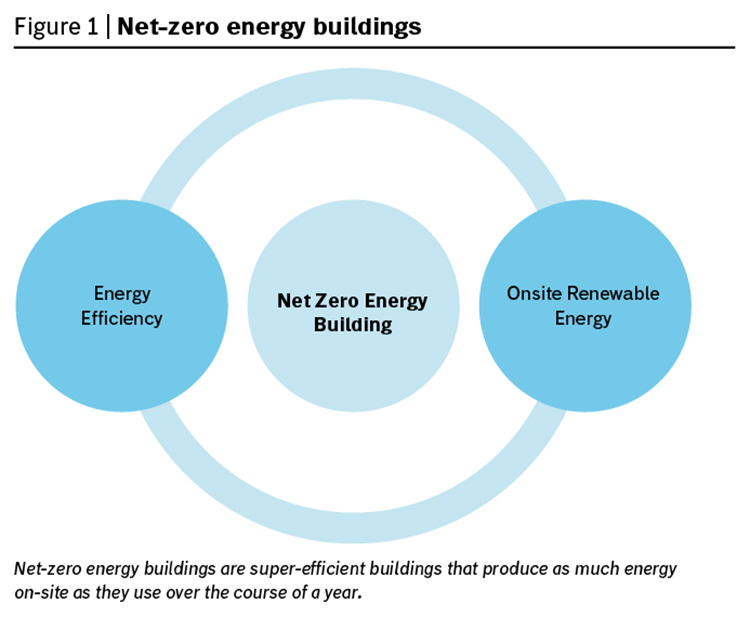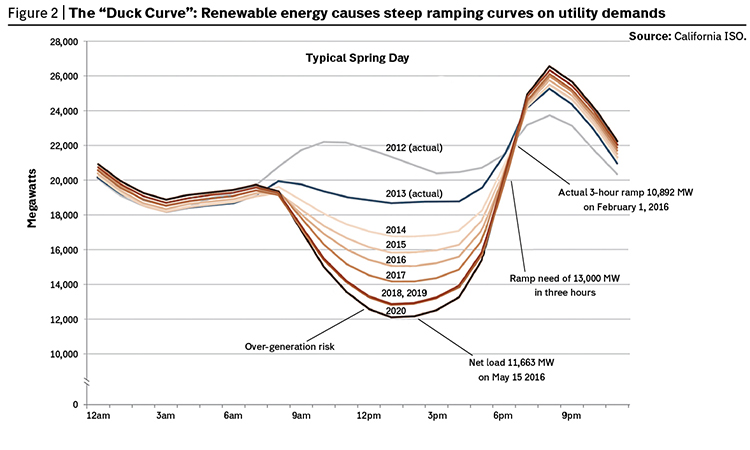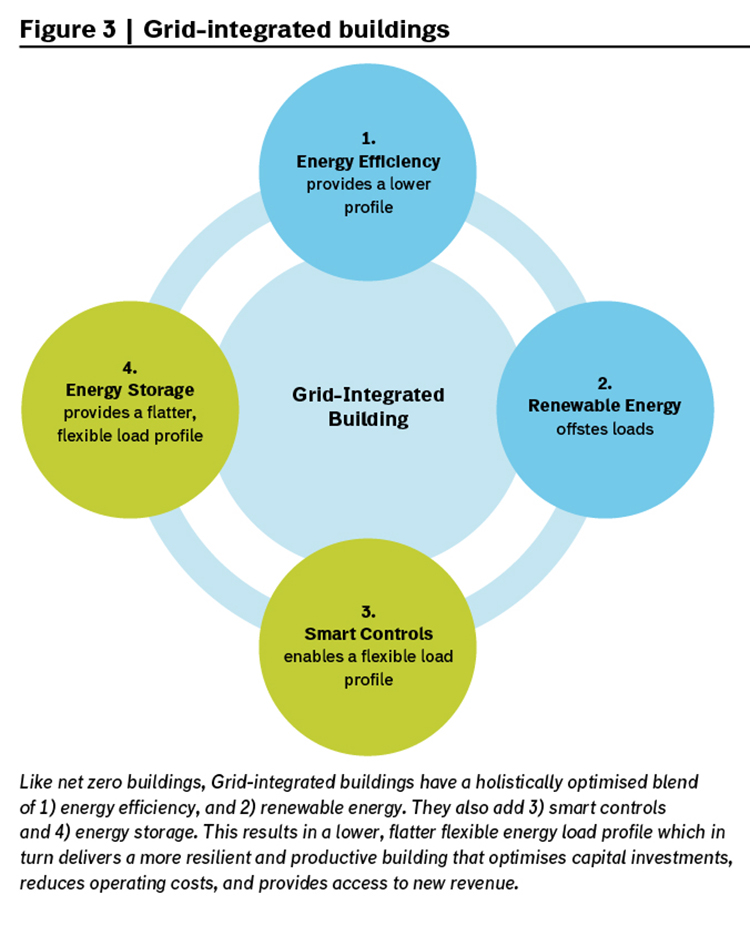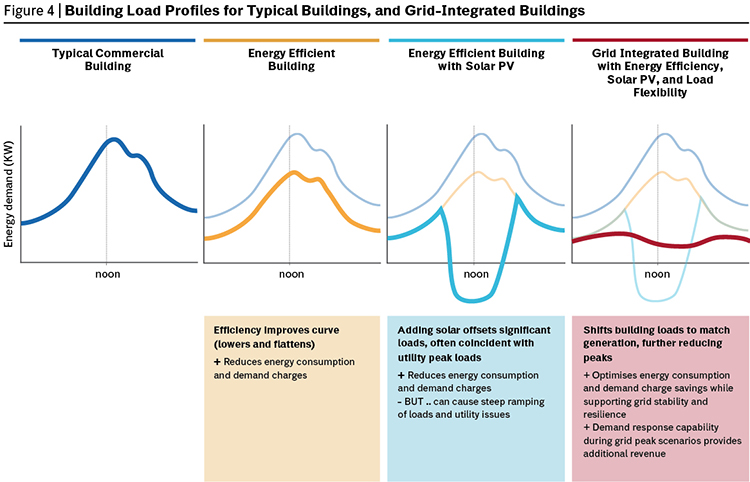Grid-interactive buildings are designed to create lower, flatter, flexible load shapes which reduce operating costs for the building owner. They can also provide services to the grid such as demand response, load shedding and distribution system balancing. Ultimately, because they coordinate with and support the grid, grid-interactive buildings support lowest cost decarbonisation of the grid, whilst providing expenditure savings and other value to building owners. Grid-interactive buildings represent a long-sought opportunity for building owners and utilities to play on the same team and share the benefits of an opportunity that all sides can profit from.
Grid-interactive buildings also align with the trends of net-zero energy buildings (which have increased by 700% over the past five years) and net-zero carbon buildings.
A Serious Issue Concerning Net-Zero Energy Buildings
At first glance, we would assume that a net-zero energy building would have a reduced environmental impact compared with a standard building. It is worth taking a closer look at this assumption.
Achieving a net-zero energy building begins with the cornerstone of a super-energy-efficient building: a good building envelope and a low energy use intensity, typically less than 30 kBtu/ft2/yr (or 94 kWh/m2/yr). Efficient HVAC approaches and controls also help minimise energy use. Finally, optimised on-site renewable energy generation options, such as geothermal, wind, or solar photovoltaics (PV), are integrated into the low-energy building to meet net-zero energy goals.
Even with each of these factors in place, all is not yet optimal for the grid – or an owner’s bottom line. Net-zero buildings typically use the grid as a “battery,” pulling energy from the grid when needed and putting excess energy back into the grid when not needed. Because of this, net-zero energy buildings are typically not net-zero carbon buildings (since they often draw carbon-intensive energy from the grid that they replace with low carbon energy), and they can often contribute to demand spikes on the grid that can also be carbon intensive. Therefore, the carbon intensity and grid-infrastructure needs of net-zero energy buildings can often be comparable with standard buildings, causing the grid to draw on dirty energy, and peaking power-generation sources at times of high demand.
Separately, in high-solar penetration markets like California and Colorado, curtailment is becoming a common occurrence. That is, utilities shed renewable power generation (from solar and wind) due to electricity supply surpassing demand during daily peaks. This is exemplified by the “duck curve”: daily load profiles showing that PV generation causes a steep drop in grid-required electricity when the sun comes up and a steep rise in electricity demand when the sun goes down. This introduces vulnerabilities to the grid and impacts the path to carbon neutrality. However, we can teach these ducks to fly by designing buildings that help create more streamlined utility load profiles (lower, flatter, more flexible load curves with less ramping).



Grid-Interactive Buildings Address These Issues
To solve these problems, we need to make our buildings smarter and more flexible, and make them participate dynamically with the grid. As with net-zero energy buildings, energy efficiency is always the first step to the lowest-cost/highest-impact carbon reduction measures. Beyond efficiency, grid-interactive buildings include a broad variety of technologies to increase their load flexibility for responding to grid signals.
The following graphs (Figure 4) are representative building load profiles. The first graph shows a typical commercial building load profile with a midday peak demand. The second scenario shows the benefit that energy efficiency provides by lowering the load profile overall and reducing energy use and demand. Energy efficiency is the highest value and most reliable load profile influencer and should be the foundation of any solution. The third scenario shows an efficient building with on-site solar PV generation. A typical net-zero energy (NZE) building may have this daily profile, which balances energy use and generation over the course of the year. However, the building still may have dramatic peak demands (e.g., when a cloud passes over, reducing PV production). The under-recognised consequences of NZE on the utility side include steep ramping up or down of generation and curtailment when the PV is overproducing. The last scenario shows an optimised blend of energy efficiency, solar PV, energy storage, and load flexibility, which delivers a much lower and flatter load profile; and with battery storage and load flexing smart controls, it enables the building to respond to grid signals. This can provide revenue potential under current rate structures and enable buildings to adjust in the future as rate structures change so buildings can continue to provide grid benefits and financial return to building owners.

Buildings need to communicate with the grid, using OpenADR or a similar smart-grid protocol, so that they can respond to utility emissions signals. Smart controls can then be coupled with advanced sub-metering and technologies such as energy storage, to enable load flexibility and allow the building to shift demand, thus contributing to operational savings.
Battery storage, which allows a building to store electricity and supply its own electricity when demand is highest, is a readily available technology for avoiding costly demand charges. A recent blog by Rocky Mountain Institute details how battery storage can be cost-effective if the building has utility rate structures with demand charges as low as $9/kW. According to a recent study by the National Renewable Energy Laboratory (NREL), “Some of the country’s highest demand charges were found to be in states not typically known for high electricity prices, such as Colorado, Nebraska, Arizona, and Georgia.” If you haven’t checked your bill recently, check again!
However, demand flexibility is not limited to electricity. It can also be implemented with thermal energy storage systems, for both heating and cooling. This is often used with water or ice storage systems. Electricity can be used to cool a material (such as water) when there is abundant and inexpensive electricity, and then the cooling from this water is used to cool the building when utility electricity is expensive thereby avoiding time-of-use or demand charges.
Some load-shifting methods can be deployed simply by operating buildings better. For example, smart controls can be used to precool high-thermal-mass buildings when hot weather is predicted, avoiding midday peak charges. Similarly, appliances such as clothes dryers and electric water heaters and even smart electric vehicle chargers can be made grid-interactive to take advantage of utility load curves.
Grid-Interactive Buildings Can Generate Income
These are a few of the many strategies we’re seeing in grid-interactive buildings. The key question remains: Should building owners and operators bother with this approach? Short answer: Yes! Building owners should care about grid integration services because such services save them money and can provide new sources of revenue.
Building owners can unlock several significant revenue streams by operating their buildings to coordinate with the electricity grid. These will vary depending on different conditions, such as utility rate structures, building opportunities, and solar resources.
Typical financial benefits for the building owners include:
- Energy charge reduction. Lower energy use (kWh) results in lower energy bills.
- Selling electricity. In areas where utilities support net metering, surplus electricity can be sold back into the grid. In areas with time-of-use rate structures, building operators can operate their buildings so that electricity is purchased when electricity costs are low and sold when it is most valuable.
- Demand charge reduction. Demand charges are based on the highest rate (kW) of electrical use during a billing period. Grid-interactive buildings that avoid these peaks result in direct, reliable cost savings on utility bills. (This is typically the largest source of financial value today.)
- Capacity/demand response. By participating in a utility’s demand response programme, where buildings respond to a utility signal to reduce electricity use at a specific time, building owners can receive a payment from the utility.
- Frequency regulation. In the group of “ancillary services” provided in the open market management of the grid, frequency regulation has the highest value. Electricity storage has the capability to do the job in milliseconds, generating a payment to the building owner for regulation services benefiting the grid.
- Resilience. The avoided cost of interruption, is a financial benefit whose scale can vary greatly depending on the circumstance. The NREL report Valuing the Resilience Provided by Solar and Battery Energy Storage Systems shows that placing a value on the losses incurred from grid disruptions can make a PV and storage system a sound investment. This report references another report that valued the cost per hour lost for various building types, including a primary school ($2,368), large hotel ($5,317), and large office space ($14,365). At these rates, battery storage becomes very attractive.
Even accessing a few of these revenue streams can dramatically change the cost-effectiveness of operating a building to optimise its grid interactions. Engaging more of them can change the paradigm of operating a building, transforming it from a cost centre into a revenue stream.
Merging Financial Value and Environmental Ideals
Electrical utilities are rapidly changing as more distributed energy resources come on line. Buildings are being increasingly recognised as an important part of the mix that will both help with this transition and help the grid run more smoothly. Utilities understand this and are beginning to enact policies to incentivise grid-sensitive building design, furthering the business case for implementation.
This is an exciting time. Grid-integrated buildings can create tangible value for both utilities and building owners. The value proposition is compelling for the utility, building owners, and building operators. Recognising the benefits to both the utility and building owners provides incentives for both parties to cooperate and share in the financial rewards.
This process is also resulting in a rapid lowest-cost decarbonisation of the grid through better integration of building-scale distributed energy resources and reduction in utility need for dirty peaking plants. More clean renewable energy is able to be used, with less curtailment. Optimisation of the building and its grid interaction is good for business – and results in a better environment for us all.
Rocky Mountain Institute, https://rmi.org
The NREL report, Valuing the Resilience Provided by Solar and Battery Energy Storage Systems; www.nrel.gov/docs/fy18osti/70679.pdf

